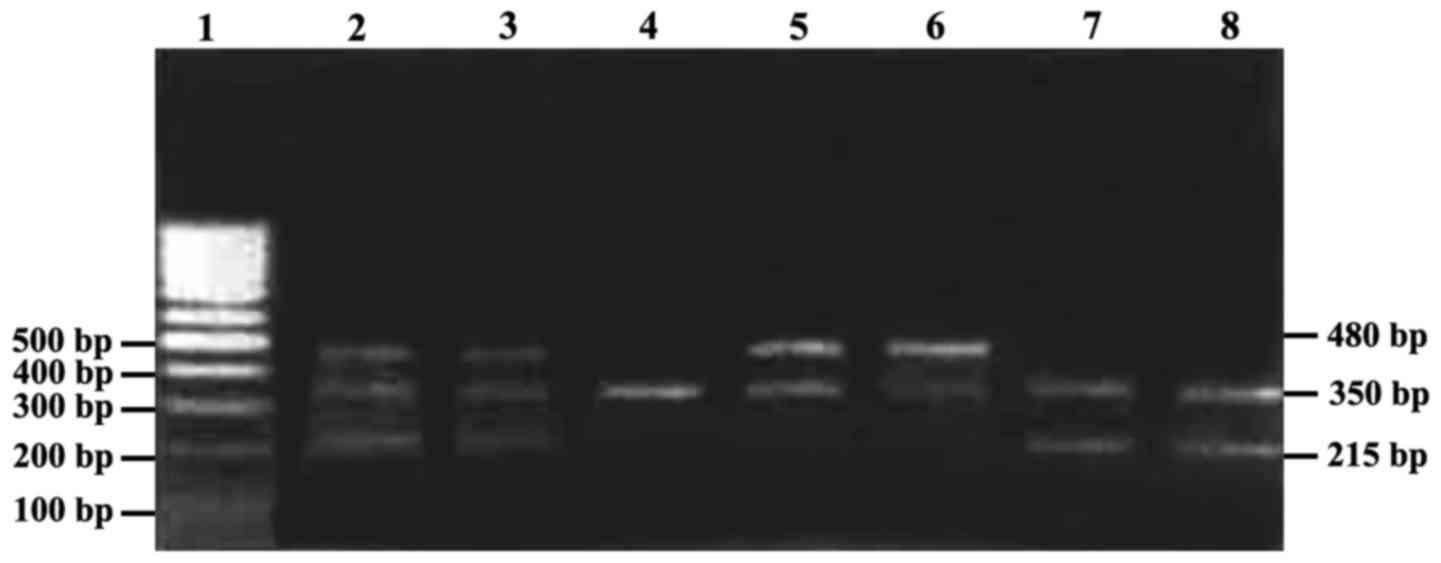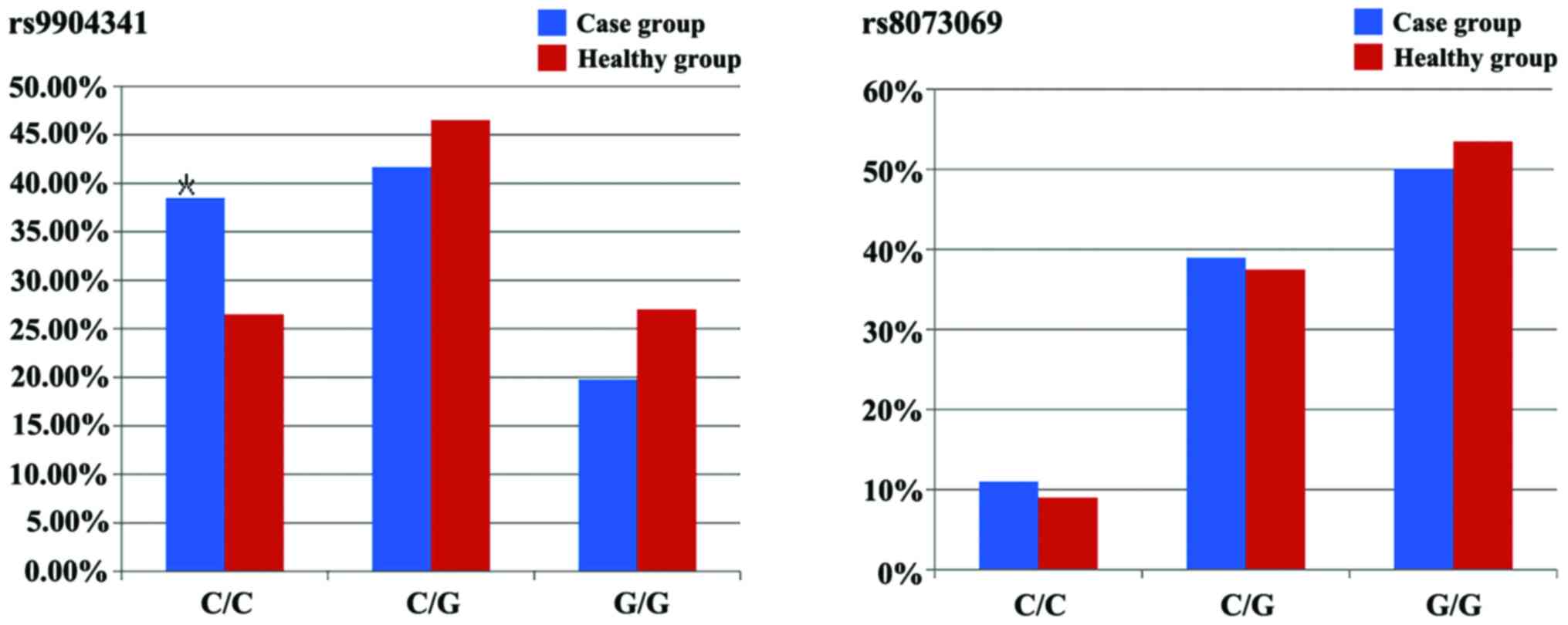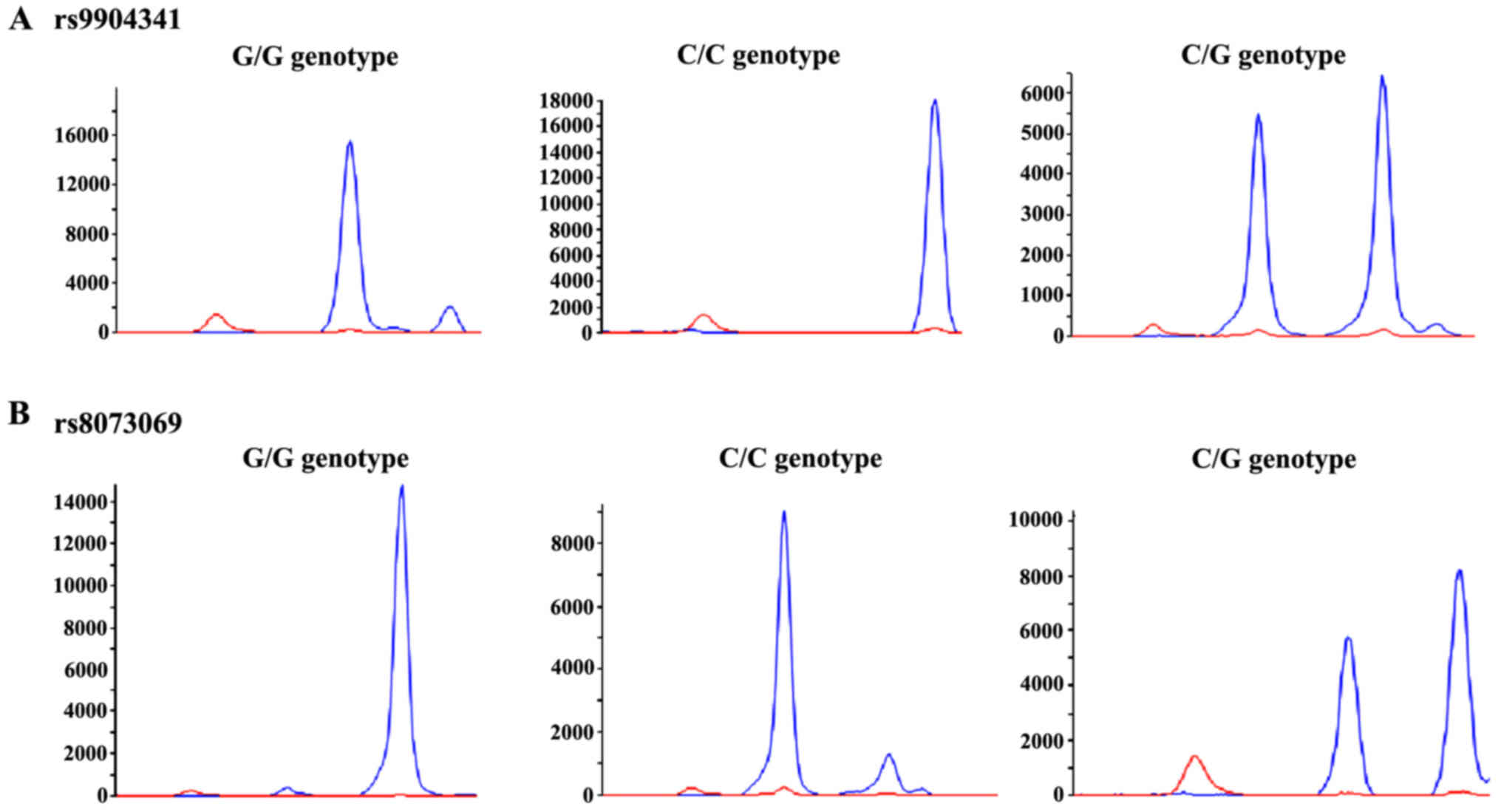Correlation between survivin polymorphism and acute leukemia of children
- Authors:
- Published online on: January 11, 2018 https://doi.org/10.3892/etm.2018.5740
- Pages: 2941-2945
-
Copyright: © Li et al. This is an open access article distributed under the terms of Creative Commons Attribution License.
Abstract
Introduction
As a kind of anti-apoptosis protein, survivin is critical to cell apoptosis (1). Also, survivin is a member in inhibitor of apoptosis protein (IAP) family, and was separated via hybridization screening of cDNA of the effector cell protease receptor-1 (EPR-1) with the human genome library by Chen (2). Survivin is specifically expressed in the G2/M phase (3), and correlated with the inhibition of cell apoptosis (2–4), cell cycle regulation (5,6) and drug resistance of tumors (7–9). Over the years, studies of survivin mostly focus on the solid tumors (10) and the leukemia of adults, and few studies reported acute leukemia (AL) of children, especially those on the polymorphism level. Single nucleotide polymorphism (SNP) can result in the variation in transcriptional activity of genes, and some SNPs in coding sequence of protein can affect the amino acid sequence of the key genes after translation, thereby altering the protein functions and further affecting the susceptibility of individuals to the disease (11). In this study, we investigated the correlation between the SNP of survivin and the AL of children, so as to provide theoretical support for prophylaxis of leukemia.
Materials and methods
Subjects
We collected 100 peripheral blood specimens from AL children (12), and 82 peripheral blood specimens from the children with acute myelogenous leukemia (AML) (13). This study was approved by the Ethics Committee of SunYat-Sen University (Guangdong, China). Signed informed consents were obtained from the patients' guardians. In these children, there were 101 males and 81 females aged between 45 days and 18 years (median age of 7.55 years). In addition, the peripheral blood samples collected from 200 healthy blood donators were enrolled as the control group. All blood samples were treated with heparin sodium and preserved at −80°C.
Extraction of whole blood genomic DNA
In accordance with the methods in literature, we extracted the genomic DNA from 3 ml of blood, and assayed the concentration and purity of DNA with ultraviolet spectrometer and through agarose electrophoresis, in which the concentration of DNA was adjusted to 100 µg/ml. Thereafter, DNA was preserved at −20°C for later use.
Identification of survivin SNPs
After reviewing the relevant literature, we found that the family of glutathione S-transferases (GSTs) (14) is involved in antagonizing the toxicity of mutagens, which is correlated with the distribution of GSTM1 polymorphism in the population.
Detection of the genotypes of GSTM1 and GSTT1
According to the nucleotide sequence of human GSTM1 and GSTT1 in National Center of Biotechnology Information (NCBI) database, the primers were designed with primer 5. GSTM1 forward, 5′-GACTCCCTGAAAAGCTAAAGC-3′ and reverse, 5′-GTTGGGCTCAAATATACGGTCG-3′; GSTT1 forward, 5′-TTCCTTACTGGTCCTCACATCTC-3′ reverse, 5′-TCACCGGATCATGGCCAGCA-3′. Albumin gene was used as the internal reference (forward, 5′-GCCCTCTGCTAACAAGTCCTAC-3′ and reverse, 5′-GCCCTAAAAAGAAAATCGCCAATC-3′). Reaction was carried out in a 50 µl amplification system [25 µl Ex Taq + 19 µl ddH2O + 2 µl forward primer (10 mM) and 2 µl reverse primer (10 mM) + 2 µl genomic DNA] under the following reaction conditions: 94°C for 5 min followed by a total of 30 cycles (94°C for 30 sec, 56°C for 45 sec and 72°C for 1 min) and extension at 72°C for 10 min, in which water was added in the negative control group. Five microliters of amplification product was taken for 1.0 agarose electrophoresis (300 V, 15 min) and stained with ethidium bromide (EB) followed by photographing with a gel imaging analyzer and image preservation.
Statistical analysis
Chi-square test was performed for comparison of data with the GSTM1/T1 homozygous deletion genotype as control, and we calculated the odds ratio (OR) and 95% confidence interval (95% CI).
Identification of the alleles C and G in SNPs of rs9904341C/G and rs8073069C/G in survivin
In this study, 182 AL children 15 and 200 healthy volunteers were enrolled as subjects, and in accordance with the case-control method, we extracted 5 ml peripheral venous blood and recorded the material of these subjects. Phenol extraction method was applied in DNA extraction from peripheral blood, and genetic typing was performed for SNPs, rs9904341C/G and rs8073069C/G (15–18), through polymerase chain reaction-ligase detection reaction (PCR-LDR) (19). Primer of rs9904341C/G on survivin forward, 5′-CGCCTCTACTCCCAGAAGGC-3′ and reverse, 5′-GAGATGCGGTGGTCCTTGAGAA-3′. Primer of rs8073069C/G on survivin forward, 5′-TCGTGCAGTCAACGATGTACT-3′ and reverse, 5′-ACAGGAGAGCTTTACAGGGTG-3′.
PCR reaction system for PCR-LDR products of rs9904341 and rs8073069: 2 µl PCR products + 1 µl 10X Taq DNA ligase buffer + 0.125 µl Taq DNA ligase (40 U/µl) + 10 µl probe (10 bp, 0.01 µl/probe and diluted to 10 µl with water). Reaction conditions: denaturation at 95°C for 3 min followed by 30 cycles with two temperatures in each cycle, 94°C for 30 sec and 56°C for 3 min.
Sequencing
Sequencing was performed on ABI3730XL sequencer (SeqGen; Inc., Torrance, CA, USA). Briefly, 1 µl ligation product was added into 10 µl loading buffer with the corresponding marker followed by denaturation at 95°C for 3 min. Thereafter, the product was placed in the ice bath and used for data analysis with GeneMapper® Software (Thermo Fisher Scientific, Inc., Waltham, MA, USA).
Results
Results of electrophoresis are shown in Fig. 1. The amplification fragments of GSTM1, GSTT1 (20) and Albumin were 215, 480 and 350 bp, respectively. As for GSTM1, homozygous deletion was recorded as GSTM/T1-0, and heterozygous deletion as GSTM-1. In the AL children, homozygous deletion rate of GSTM1/T1 was significantly higher than that in the control group (case group, 76.12 vs. 52.74%, OR=2.856, 95% CI=1.493–5.465, P=0.001; control group, 50.74 vs. 24.66%, OR=3.148, 95% CI=1.712–5.789, P=0.0001); in AML children, homozygous deletion rate of GSTM1 was significantly higher than that in the control group (71.88 vs. 52.74%, OR=2.290, 95% CI=0.992–5.285, P=0.048); comparisons of the homozygous deletion rates between the control group (49.32%) and the AL patients (62.29%) and the AML patients (59.38%) showed no statistically significant difference (P>0.05).
 | Figure 1.100 bp marker; lanes 2 and 3, GSTM/T1-1; 4, GSTM1/T1-0; 5 and 6, GSTT1-1; 7 and 8, GSTM1-1. |
Alleles C and G in rs9904341C/G of survivin. In the case group and healthy group, the frequencies of C and G alleles wer e 59.3 and 41.7%, 46.7 and 50.3%, respectively, and the coherence comparison showed that the difference had statistical significance (P=0.008). In the case group and healthy group, the frequencies of C/C, C/G and G/G were 38.5, 41.7, 19.8% and 26.5, 46.5, 27.0%, respectively, and the comparison between the two groups showed that the differences had statistical significance (P=0.033). The frequency of C/C genotype (38.5%) in the case group was significantly higher than that (26.5%) in the healthy group, and compared with C/C genotype, C/G and G/G genotypes could decrease the risk coefficient of leukemia.
In the case group and healthy group, the frequencies of C and G alleles on rs8073069C/G in survivin were 30.5 and 69.5, 27.7 and 72.3%, respectively, and the comparison showed that the difference was not statistically significant (P=0.404). In the case group and healthy group, the frequencies of C/C, C/G and G/G were 11, 39.0, 50.0% and 9.0, 37.5, 53.5%, respectively, and the comparison between the two groups showed that the differences were not statistically significant (P=0.62). Compared with C/C genotype, C/G and G/G genotypes showed no influences on the risk of leukemia (Figs. 2 and 3).
Comparison via ABI3730XL sequencer (SeqGen, Inc., Torrance, CA, USA) showed a linkage disequilibrium in the SNPs of survivin, rs9904341 and rs8073069 (D'=0.628). The most common haplotype was rs9904341C-8073069G, and its frequency in the healthy group was 49.8% following the rs9904341G-8073069C (27.5%), rs9904341G-8073069G (22.5%) and rs9904341C-8073069C (0.2%). In population, the haplotype of rs9904341C-8073069C may result in an increase in risk of onset, and compared with its haplotype, the onset risk of AL could be dramatically decreased in population with rs9904341G-8073069C (Table I).
Table I.Comparison of the haplotypes of rs9904341 and rs8073069 on survivin between the healthy group and the case group. |
Discussion
As known, the incidence rate of AL in children is increasing year by year, and AL has become the prevalent malignant tumor in children. The development of AL in children is regulated by multiple genes and affected by a variety of cytokines (21). Survivin, a new member of the anti-apoptosis protein family, is a protein with the smallest relative molecular weight in this family, it can directly or indirectly modulate the activity of asparagine-specific proteinase through regulating the cell proliferation, thereby controlling cell apoptosis; survivin is mainly distributed in the malignant tumor tissues, and scarcely or not expressed in the normal tissues (22). Survivin gene exhibits tremendous effect on structural variation of amino acid. For example, in α-helical structure of survivin protein, the replacement of lysine (an essential basic amino acid) by glutamic acid (an acidic amino acid with two carboxyl groups) can result in the two kinds of variations in biological functions: First, it can lead to alteration in focal spatial structure; second, it can induce an increase in the number of phosphorylation sites (23,24).
SNP refers to the polymorphism in DNA sequence generated by the mutation of a nucleotide in the chromosome genomes, including the conversion and transversion. Specifically, it involves the changes between the purines and pyrimidines (25,26). SNPs have been used as the 3rd generation of molecular marker with promising development potential (27). At present, increasing number of studies have focused on SNPs (28,29). For example, SNPs in promotor regions of 31C/G, −24T/C, −625G/C, −644T/C and 1547A/G, can affect the genetic predisposition of tumors (30). Studies have confirmed that the abnormal polymorphism of survivin may be closely related to the metastasis and prognosis of malignant tumors.
In conclusion, the results of this study showed that SNP of rs9904341C/G on survivin may affect the onset risk of AL, and patients with C/C genotype may suffer from an increase in onset of risk. Compared with C/C genotype, C/G and G/G genotype can significantly reduce the onset risk of AL. The results on the rs8073069C/G SNP suggested that this SNP is not correlated with the onset risk of AL. In conclusion, the study on SNPs of survivin can be used for assessment of disease condition and prognosis of AL in children, which can serve as the evidence base for clinical practice.
Competing interests
The authors declare that they have no competing interests.
References
|
Deveraux QL, Takahashi R, Salvesen GS and Reed JC: X-linked IAP is a direct inhibitor of cell-death proteases. Nature. 388:300–304. 1997. View Article : Google Scholar : PubMed/NCBI | |
|
Chen G: The relationship between the expression of TAM, survivin and the degree of necrosis of the tumor after cisplatin treatment in osteosarcoma. Eur Rev Med Pharmacol Sci. 21:490–497. 2017.PubMed/NCBI | |
|
Musacchio A: Spindle assembly checkpoint: The third decade. Philos Trans R Soc Lond B Biol Sci. 366:3595–3604. 2011. View Article : Google Scholar : PubMed/NCBI | |
|
Kuo ML, Shen SC, Yang CH, Chuang SE, Cheng AL and Huang TS: Bcl-2 prevents topoisomerase II inhibitor GL331-induced apoptosis is mediated by down-regulation of poly(ADP-ribose)polymerase activity. Oncogene. 17:2225–2234. 1998. View Article : Google Scholar : PubMed/NCBI | |
|
O'Connor DS, Grossman D, Plescia J, Li F, Zhang H, Villa A, Tognin S, Marchisio PC and Altieri DC: Regulation of apoptosis at cell division by p34cdc2 phosphorylation of survivin. Proc Natl Acad Sci USA. 97:pp. 13103–13107. 2000; View Article : Google Scholar : PubMed/NCBI | |
|
Shin S, Sung BJ, Cho YS, Kim HJ, Ha NC, Hwang JI, Chung CW, Jung YK and Oh BH: An anti-apoptotic protein human survivin is a direct inhibitor of caspase-3 and −7. Biochemistry. 40:1117–1123. 2001. View Article : Google Scholar : PubMed/NCBI | |
|
Suzuki A, Ito T, Kawano H, Hayashida M, Hayasaki Y, Tsutomi Y, Akahane K, Nakano T, Miura M and Shiraki K: Survivin initiates procaspase 3/p21 complex formation as a result of interaction with Cdk4 to resist Fas-mediated cell death. Oncogene. 19:1346–1353. 2000. View Article : Google Scholar : PubMed/NCBI | |
|
Olie RA, Simões-Wüst AP, Baumann B, Leech SH, Fabbro D, Stahel RA and Zangemeister-Wittke U: A novel antisense oligonucleotide targeting survivin expression induces apoptosis and sensitizes lung cancer cells to chemotherapy. Cancer Res. 60:2805–2809. 2000.PubMed/NCBI | |
|
Tamm I, Wang Y, Sausville E, Scudiero DA, Vigna N, Oltersdorf T and Reed JC: IAP-family protein survivin inhibits caspase activity and apoptosis induced by Fas (CD95), Bax, caspases, and anticancer drugs. Cancer Res. 58:5315–5320. 1998.PubMed/NCBI | |
|
Kappler M, Köhler T, Kampf C, Diestelkötter P, Würl P, Schmitz M, Bartel F, Lautenschläger C, Rieber EP, Schmidt H, et al: Increased survivin transcript levels: An independent negative predictor of survival in soft tissue sarcoma patients. Int J Cancer. 95:360–363. 2001.PubMed/NCBI | |
|
Pui CH and Evans WE: Treatment of acute lymphoblastic leukemia. N Engl J Med. 354:166–178. 2006. View Article : Google Scholar : PubMed/NCBI | |
|
Campana D, Coustan-Smith E, Manabe A, Buschle M, Raimondi SC, Behm FG, Ashmun R, Aricò M, Biondi A and Pui CH: Prolonged survival of B-lineage acute lymphoblastic leukemia cells is accompanied by overexpression of bcl-2 protein. Blood. 81:1025–1031. 1993.PubMed/NCBI | |
|
Flotho C, Coustan-Smith E, Pei D, Iwamoto S, Song G, Cheng C, Pui CH, Downing JR and Campana D: Genes contributing to minimal residual disease in childhood acute lymphoblastic leukemia: Prognostic significance of CASP8AP2. Blood. 108:1050–1057. 2006. View Article : Google Scholar : PubMed/NCBI | |
|
Jaskoll T, Chen H, Min Zhou Y, Wu D and Melnick M: Developmental expression of survivin during embryonic submandibular salivary gland development. BMC Dev Biol. 1:52001. View Article : Google Scholar : PubMed/NCBI | |
|
Pui CH, Relling MV and Downing JR: Acute lymphoblastic leukemia. N Engl J Med. 350:1535–1548. 2004. View Article : Google Scholar : PubMed/NCBI | |
|
Krajinovic M, Labuda D, Richer C, Karimi S and Sinnett D: Susceptibility to childhood acute lymphoblastic leukemia: Influence of CYP1A1, CYP2D6, GSTM1, and GSTT1 genetic polymorphisms. Blood. 93:1496–1501. 1999.PubMed/NCBI | |
|
Canalle R, Burim RV, Tone LG and Takahashi CS: Genetic polymorphisms and susceptibility to childhood acute lymphoblastic leukemia. Environ Mol Mutagen. 43:100–109. 2004. View Article : Google Scholar : PubMed/NCBI | |
|
Lanciotti M, Dufour C, Corral L, Di Michele P, Pigullo S, De Rossi G, Basso G, Leszl A, Luciani M, Lo Nigro L, et al: Genetic polymorphism of NAD(P)H:quinone oxidoreductase is associated with an increased risk of infant acute lymphoblastic leukemia without MLL gene rearrangements. Leukemia. 19:214–216. 2005. View Article : Google Scholar : PubMed/NCBI | |
|
Bolufer P, Barragan E, Collado M, Cervera J, López JA and Sanz MA: Influence of genetic polymorphisms on the risk of developing leukemia and on disease progression. Leuk Res. 30:1471–1491. 2006. View Article : Google Scholar : PubMed/NCBI | |
|
Aydin-Sayitoglu M, Hatirnaz O, Erensoy N and Ozbek U: Role of CYP2D6, CYP1A1, CYP2E1, GSTT1, and GSTM1 genes in the susceptibility to acute leukemias. Am J Hematol. 81:162–170. 2006. View Article : Google Scholar : PubMed/NCBI | |
|
d'Errico A, Mamo C, Costa G, Filippi M and Crosignani P: Use of pension records for occupational health surveillance: Example of record-linkage with hospital discharge records to study the association between work and the incidence of leukaemias, lung and bladder cancer, and miscarriage. Med Lav. 96(Suppl): s147–s160. 2005.(In Italian). PubMed/NCBI | |
|
LaCasse EC, Baird S, Korneluk RG and MacKenzie AE: The inhibitors of apoptosis (IAPs) and their emerging role in cancer. Oncogene. 17:3247–3259. 1998. View Article : Google Scholar : PubMed/NCBI | |
|
Gilbert ME and Shafer TJ: In vitro exposure to aluminum does not alter long-term potentiation or glutamate release in rat hippocampal slices. Neurotoxicol Teratol. 18:175–180. 1996. View Article : Google Scholar : PubMed/NCBI | |
|
Takashima A, Noguchi K, Michel G, Mercken M, Hoshi M, Ishiguro K and Imahori K: Exposure of rat hippocampal neurons to amyloid beta peptide (25–35) induces the inactivation of phosphatidyl inositol-3 kinase and the activation of tau protein kinase I/glycogen synthase kinase-3 beta. Neurosci Lett. 203:33–36. 1996. View Article : Google Scholar : PubMed/NCBI | |
|
Mullikin JC, Hunt SE, Cole CG, Mortimore BJ, Rice CM, Burton J, Matthews LH, Pavitt R, Plumb RW, Sims SK, et al: An SNP map of human chromosome 22. Nature. 407:516–520. 2000. View Article : Google Scholar : PubMed/NCBI | |
|
Altshuler D, Pollara VJ, Cowles CR, Van Etten WJ, Baldwin J, Linton L and Lander ES: An SNP map of the human genome generated by reduced representation shotgun sequencing. Nature. 407:513–516. 2000. View Article : Google Scholar : PubMed/NCBI | |
|
Gray IC, Campbell DA and Spurr NK: Single nucleotide polymorphisms as tools in human genetics. Hum Mol Genet. 9:2403–2408. 2000. View Article : Google Scholar : PubMed/NCBI | |
|
Carlson CS, Eberle MA, Rieder MJ, Yi Q, Kruglyak L and Nickerson DA: Selecting a maximally informative set of single-nucleotide polymorphisms for association analyses using linkage disequilibrium. Am J Hum Genet. 74:106–120. 2004. View Article : Google Scholar : PubMed/NCBI | |
|
Nowotny P, Kwon JM and Goate AM: SNP analysis to dissect human traits. Curr Opin Neurobiol. 11:637–641. 2001. View Article : Google Scholar : PubMed/NCBI | |
|
Jang JS, Kim KM, Kang KH, Choi JE, Lee WK, Kim CH, Kang YM, Kam S, Kim IS, Jun JE, et al: Polymorphisms in the survivin gene and the risk of lung cancer. Lung Cancer. 60:31–39. 2008. View Article : Google Scholar : PubMed/NCBI |











